Chapter 17 INCREASING AND DECREASING
Class 12th Maths R D Sharma Solution
Access answers to Maths RD Sharma Solutions For Class 12 Chapter 17 – Increasing and Decreasing Functions
Exercise 17.1 Page No: 17.10
1. Prove that the function f(x) = loge x is increasing on (0, ∞).
Solution:
Let x1, x2 ∈ (0, ∞)
We have, x1 < x2
⇒ loge x1 < loge x2
⇒ f (x1) < f (x2)
So, f(x) is increasing in (0, ∞)
2. Prove that the function f(x) = loga x is increasing on (0, ∞) if a > 1 and decreasing on (0, ∞), if 0 < a < 1.
Solution:
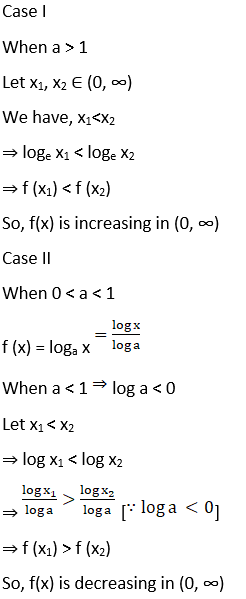
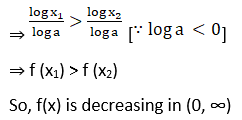
3. Prove that f(x) = ax + b, where a, b are constants and a > 0 is an increasing function on R.
Solution:
Given,
f (x) = ax + b, a > 0
Let x1, x2 ∈ R and x1 > x2
⇒ ax1 > ax2 for some a > 0
⇒ ax1 + b> ax2 + b for some b
⇒ f (x1) > f(x2)
Hence, x1 > x2 ⇒ f(x1) > f(x2)
So, f(x) is increasing function of R
4. Prove that f(x) = ax + b, where a, b are constants and a < 0 is a decreasing function on R.
Solution:
Given,
f (x) = ax + b, a < 0
Let x1, x2 ∈ R and x1 > x2
⇒ ax1 < ax2 for some a > 0
⇒ ax1 + b < ax2 + b for some b
⇒ f (x1) < f(x2)
Hence, x1 > x2⇒ f(x1) < f(x2)
So, f(x) is decreasing function of R
Exercise 17.2 Page No: 17.33
1. Find the intervals in which the following functions are increasing or decreasing.
(i) f (x) = 10 – 6x – 2x2
Solution:
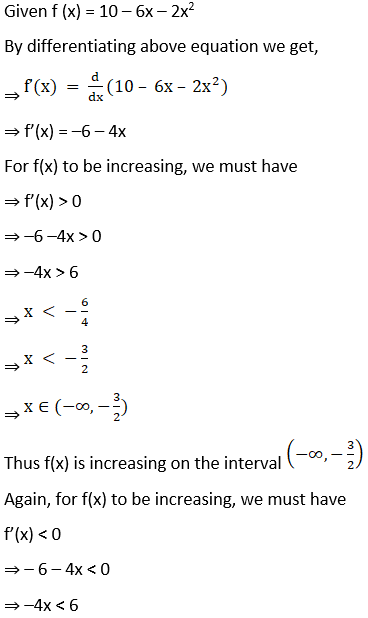
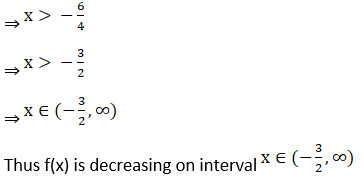
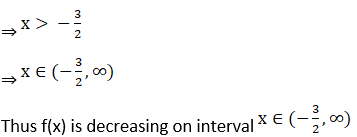
(ii) f (x) = x2 + 2x – 5
Solution:
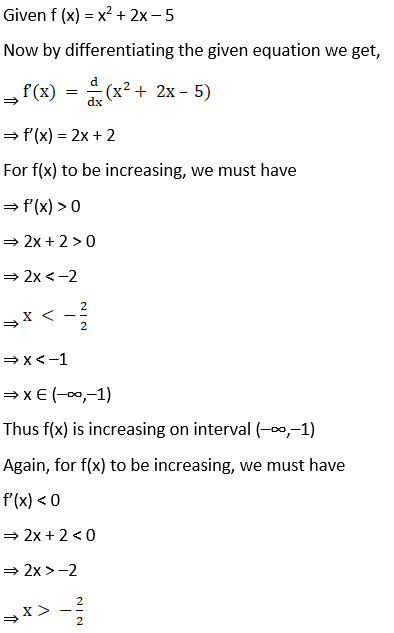
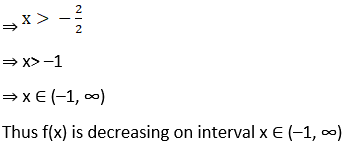
(iii) f (x) = 6 – 9x – x2
Solution:
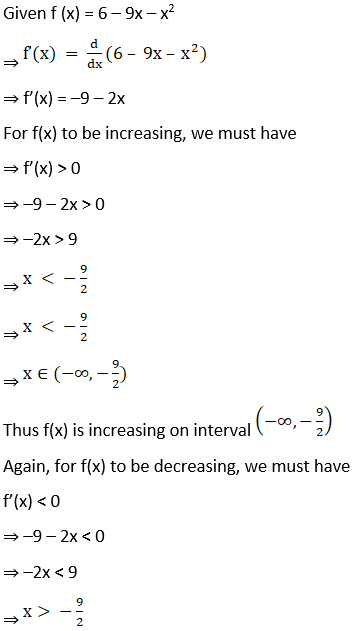
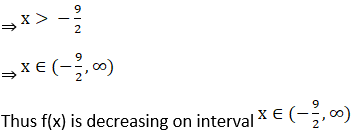
(iv) f(x) = 2x3 – 12x2 + 18x + 15
Solution:
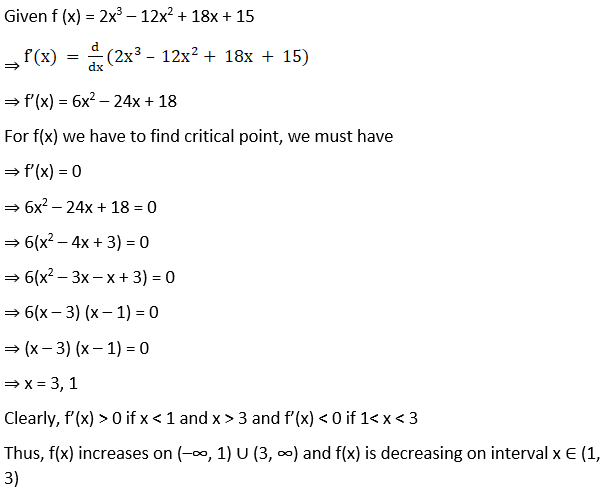
(v) f (x) = 5 + 36x + 3x2 – 2x3
Solution:
Given f (x) = 5 + 36x + 3x2 – 2x3
⇒
⇒ f’(x) = 36 + 6x – 6x2
For f(x) now we have to find critical point, we must have
⇒ f’(x) = 0
⇒ 36 + 6x – 6x2 = 0
⇒ 6(–x2 + x + 6) = 0
⇒ 6(–x2 + 3x – 2x + 6) = 0
⇒ –x2 + 3x – 2x + 6 = 0
⇒ x2 – 3x + 2x – 6 = 0
⇒ (x – 3) (x + 2) = 0
⇒ x = 3, – 2
Clearly, f’(x) > 0 if –2< x < 3 and f’(x) < 0 if x < –2 and x > 3
Thus, f(x) increases on x ∈ (–2, 3) and f(x) is decreasing on interval (–∞, –2) ∪ (3, ∞)
(vi) f (x) = 8 + 36x + 3x2 – 2x3
Solution:
Given f (x) = 8 + 36x + 3x2 – 2x3
Now differentiating with respect to x
⇒
⇒ f’(x) = 36 + 6x – 6x2
For f(x) we have to find critical point, we must have
⇒ f’(x) = 0
⇒ 36 + 6x – 6x2 = 0
⇒ 6(–x2 + x + 6) = 0
⇒ 6(–x2 + 3x – 2x + 6) = 0
⇒ –x2 + 3x – 2x + 6 = 0
⇒ x2 – 3x + 2x – 6 = 0
⇒ (x – 3) (x + 2) = 0
⇒ x = 3, – 2
Clearly, f’(x) > 0 if –2 < x < 3 and f’(x) < 0 if x < –2 and x > 3
Thus, f(x) increases on x ∈ (–2, 3) and f(x) is decreasing on interval (–∞, 2) ∪ (3, ∞)
(vii) f(x) = 5x3 – 15x2 – 120x + 3
Solution:
Given f(x) = 5x3 – 15x2 – 120x + 3
Now by differentiating above equation with respect x, we get
⇒
⇒ f’(x) = 15x2 – 30x – 120
For f(x) we have to find critical point, we must have
⇒ f’(x) = 0
⇒ 15x2 – 30x – 120 = 0
⇒ 15(x2 – 2x – 8) = 0
⇒ 15(x2 – 4x + 2x – 8) = 0
⇒ x2 – 4x + 2x – 8 = 0
⇒ (x – 4) (x + 2) = 0
⇒ x = 4, – 2
Clearly, f’(x) > 0 if x < –2 and x > 4 and f’(x) < 0 if –2 < x < 4
Thus, f(x) increases on (–∞,–2) ∪ (4, ∞) and f(x) is decreasing on interval x ∈ (–2, 4)
(viii) f(x) = x3 – 6x2 – 36x + 2
Solution:
Given f (x) = x3 – 6x2 – 36x + 2
⇒
⇒ f’(x) = 3x2 – 12x – 36
For f(x) we have to find critical point, we must have
⇒ f’(x) = 0
⇒ 3x2 – 12x – 36 = 0
⇒ 3(x2 – 4x – 12) = 0
⇒ 3(x2 – 6x + 2x – 12) = 0
⇒ x2 – 6x + 2x – 12 = 0
⇒ (x – 6) (x + 2) = 0
⇒ x = 6, – 2
Clearly, f’(x) > 0 if x < –2 and x > 6 and f’(x) < 0 if –2< x < 6
Thus, f(x) increases on (–∞,–2) ∪ (6, ∞) and f(x) is decreasing on interval x ∈ (–2, 6)
(ix) f(x) = 2x3 – 15x2 + 36x + 1
Solution:
Given f (x) = 2x3 – 15x2 + 36x + 1
Now by differentiating above equation with respect x, we get
⇒
⇒ f’(x) = 6x2 – 30x + 36
For f(x) we have to find critical point, we must have
⇒ f’(x) = 0
⇒ 6x2 – 30x + 36 = 0
⇒ 6 (x2 – 5x + 6) = 0
⇒ 6(x2 – 3x – 2x + 6) = 0
⇒ x2 – 3x – 2x + 6 = 0
⇒ (x – 3) (x – 2) = 0
⇒ x = 3, 2
Clearly, f’(x) > 0 if x < 2 and x > 3 and f’(x) < 0 if 2 < x < 3
Thus, f(x) increases on (–∞, 2) ∪ (3, ∞) and f(x) is decreasing on interval x ∈ (2, 3)
(x) f (x) = 2x3 + 9x2 + 12x + 20
Solution:
Given f (x) = 2x3 + 9x2 + 12x + 20
Differentiating above equation we get
⇒
⇒ f’(x) = 6x2 + 18x + 12
For f(x) we have to find critical point, we must have
⇒ f’(x) = 0
⇒ 6x2 + 18x + 12 = 0
⇒ 6(x2 + 3x + 2) = 0
⇒ 6(x2 + 2x + x + 2) = 0
⇒ x2 + 2x + x + 2 = 0
⇒ (x + 2) (x + 1) = 0
⇒ x = –1, –2
Clearly, f’(x) > 0 if –2 < x < –1 and f’(x) < 0 if x < –1 and x > –2
Thus, f(x) increases on x ∈ (–2,–1) and f(x) is decreasing on interval (–∞, –2) ∪ (–2, ∞)
2. Determine the values of x for which the function f(x) = x2 – 6x + 9 is increasing or decreasing. Also, find the coordinates of the point on the curve y = x2 – 6x + 9 where the normal is parallel to the line y = x + 5.
Solution:
Given f(x) = x2 – 6x + 9
⇒
⇒ f’(x) = 2x – 6
⇒ f’(x) = 2(x – 3)
For f(x) let us find critical point, we must have
⇒ f’(x) = 0
⇒ 2(x – 3) = 0
⇒ (x – 3) = 0
⇒ x = 3
Clearly, f’(x) > 0 if x > 3 and f’(x) < 0 if x < 3
Thus, f(x) increases on (3, ∞) and f(x) is decreasing on interval x ∈ (–∞, 3)
Now, let us find coordinates of point
Equation of curve is f(x) = x2 – 6x + 9
Slope of this curve is given by
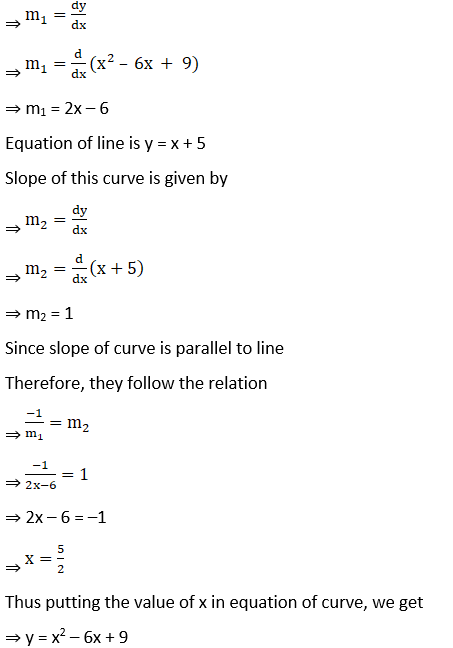
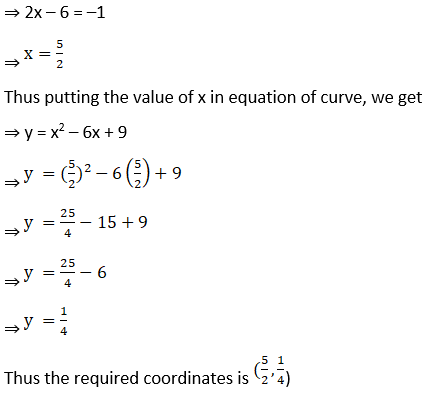
3. Find the intervals in which f(x) = sin x – cos x, where 0 < x < 2π is increasing or decreasing.
Solution:
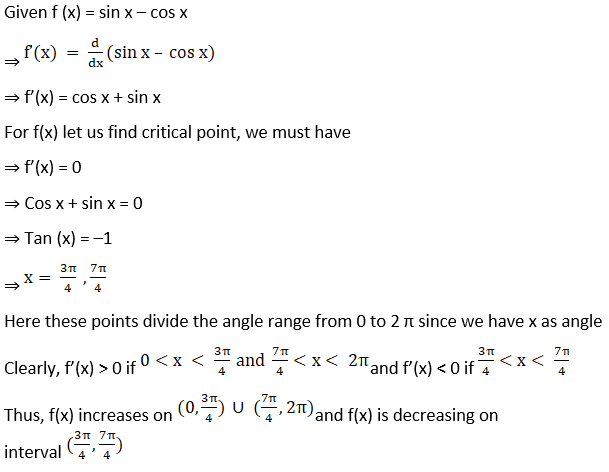

4. Show that f(x) = e2x is increasing on R.
Solution:
Given f (x) = e2x
⇒
⇒ f’(x) = 2e2x
For f(x) to be increasing, we must have
⇒ f’(x) > 0
⇒ 2e2x > 0
⇒ e2x > 0
Since, the value of e lies between 2 and 3
So, whatever be the power of e (that is x in domain R) will be greater than zero.
Thus f(x) is increasing on interval R
5. Show that f (x) = e1/x, x ≠ 0 is a decreasing function for all x ≠ 0.
Solution:
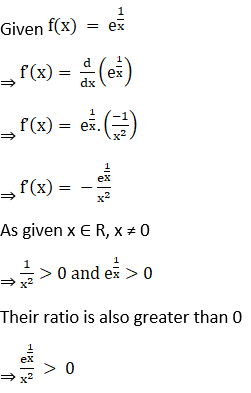
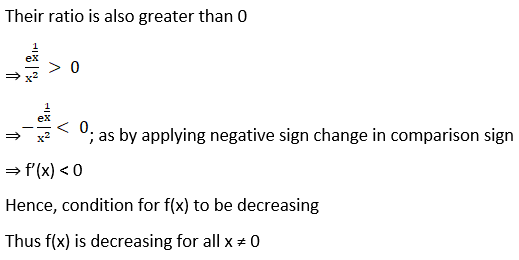
6. Show that f(x) = loga x, 0 < a < 1 is a decreasing function for all x > 0.
Solution:
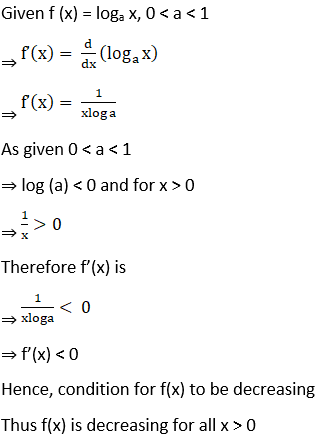
7. Show that f(x) = sin x is increasing on (0, π/2) and decreasing on (π/2, π) and neither increasing nor decreasing in (0, π).
Solution:
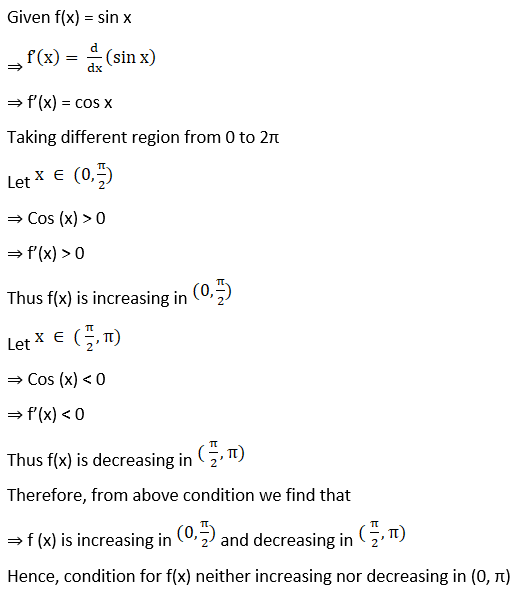
8. Show that f(x) = log sin x is increasing on (0, π/2) and decreasing on (π/2, π).
Solution:
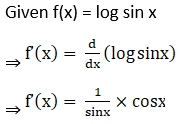
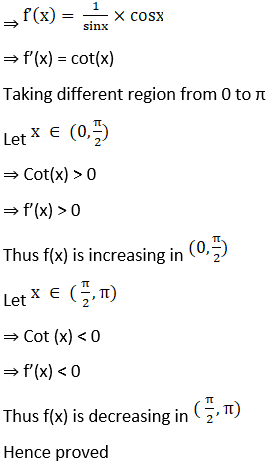
9. Show that f(x) = x – sin x is increasing for all x ϵ R.
Solution:
Given f (x) = x – sin x
⇒
⇒ f’(x) = 1 – cos x
Now, as given x ϵ R
⇒ –1 < cos x < 1
⇒ –1 > cos x > 0
⇒ f’(x) > 0
Hence, condition for f(x) to be increasing
Thus f(x) is increasing on interval x ∈ R
10. Show that f(x) = x3 – 15x2 + 75x – 50 is an increasing function for all x ϵ R.
Solution:
Given f(x) = x3 – 15x2 + 75x – 50
⇒
⇒ f’(x) = 3x2 – 30x + 75
⇒ f’(x) = 3(x2 – 10x + 25)
⇒ f’(x) = 3(x – 5)2
Now, as given x ϵ R
⇒ (x – 5)2 > 0
⇒ 3(x – 5)2 > 0
⇒ f’(x) > 0
Hence, condition for f(x) to be increasing
Thus f(x) is increasing on interval x ∈ R
11. Show that f(x) = cos2 x is a decreasing function on (0, π/2).
Solution:
Given f (x) = cos2 x
⇒
⇒ f’(x) = 2 cos x (–sin x)
⇒ f’(x) = –2 sin (x) cos (x)
⇒ f’(x) = –sin2x
Now, as given x belongs to (0, π/2).
⇒ 2x ∈ (0, π)
π)
⇒ Sin (2x)> 0
⇒ –Sin (2x) < 0
⇒ f’(x) < 0
Hence, condition for f(x) to be decreasing
Thus f(x) is decreasing on interval (0, π/2).
Hence proved
12. Show that f(x) = sin x is an increasing function on (–π/2, π/2).
Solution:
Given f (x) = sin x
⇒
⇒ f’(x) = cos x
Now, as given x ∈ (–π/2, π/2).
That is 4th quadrant, where
⇒ Cos x> 0
⇒ f’(x) > 0
Hence, condition for f(x) to be increasing
Thus f(x) is increasing on interval (–π/2, π/2).
13. Show that f(x) = cos x is a decreasing function on (0, π), increasing in (–π, 0) and neither increasing nor decreasing in (–π, π).
Solution:
Given f(x) = cos x
⇒
⇒ f’(x) = –sin x
Taking different region from 0 to 2π
Let x ∈ (0, π).
⇒ Sin(x) > 0
⇒ –sin x < 0
⇒ f’(x) < 0
Thus f(x) is decreasing in (0, π)
Let x ∈ (–π, o).
⇒ Sin (x) < 0
⇒ –sin x > 0
⇒ f’(x) > 0
Thus f(x) is increasing in (–π, 0).
Therefore, from above condition we find that
⇒ f (x) is decreasing in (0, π) and increasing in (–π, 0).
Hence, condition for f(x) neither increasing nor decreasing in (–π, π)
14. Show that f(x) = tan x is an increasing function on (–π/2, π/2).
Solution:
Given f (x) = tan x
⇒
⇒ f’(x) = sec2x
Now, as given
x ∈ (–π/2, π/2).
That is 4th quadrant, where
⇒ sec2x > 0
⇒ f’(x) > 0
Hence, Condition for f(x) to be increasing
Thus f(x) is increasing on interval (–π/2, π/2).
15. Show that f(x) = tan–1 (sin x + cos x) is a decreasing function on the interval (π/4, π /2).
Solution:
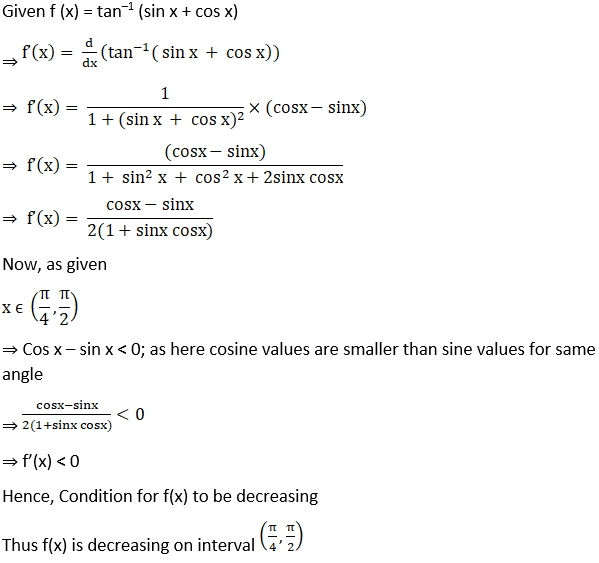
16. Show that the function f (x) = sin (2x + π/4) is decreasing on (3π/8, 5π/8).
Solution:
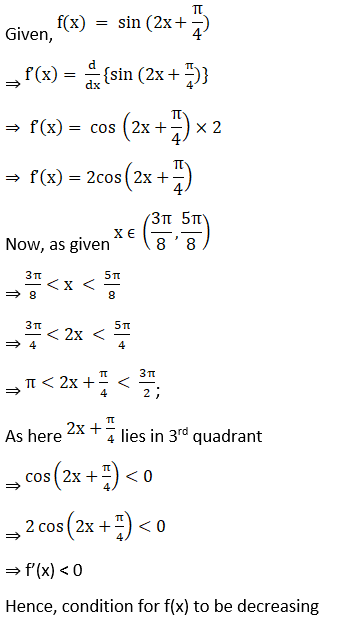
Thus f (x) is decreasing on the interval (3π/8, 5π/8).
17. Show that the function f(x) = cot–1 (sin x + cos x) is decreasing on (0, π/4) and increasing on (π/4, π/2).
Solution:
Given f(x) = cot–1 (sin x + cos x)
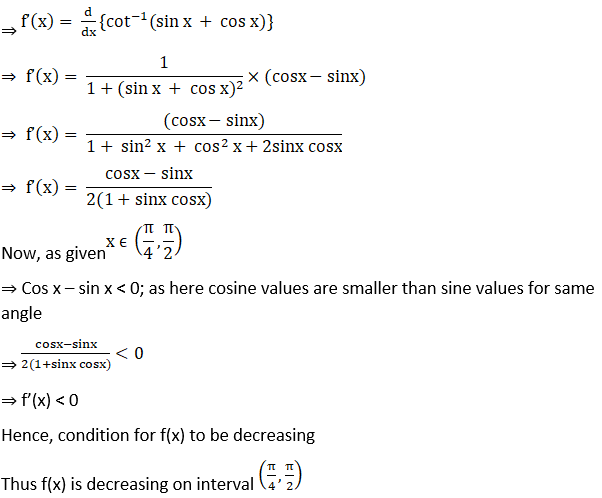
18. Show that f(x) = (x – 1) ex + 1 is an increasing function for all x > 0.
Solution:
Given f (x) = (x – 1) ex + 1
Now differentiating the given equation with respect to x, we get
⇒
⇒ f’(x) = ex + (x – 1) ex
⇒ f’(x) = ex(1+ x – 1)
⇒ f’(x) = x ex
As given x > 0
⇒ ex > 0
⇒ x ex > 0
⇒ f’(x) > 0
Hence, condition for f(x) to be increasing
Thus f(x) is increasing on interval x > 0
19. Show that the function x2 – x + 1 is neither increasing nor decreasing on (0, 1).
Solution:
Given f(x) = x2 – x + 1
Now by differentiating the given equation with respect to x, we get
⇒
⇒ f’(x) = 2x – 1
Taking different region from (0, 1)
Let x ∈ (0, ½)
⇒ 2x – 1 < 0
⇒ f’(x) < 0
Thus f(x) is decreasing in (0, ½)
Let x ∈ (½, 1)
⇒ 2x – 1 > 0
⇒ f’(x) > 0
Thus f(x) is increasing in (½, 1)
Therefore, from above condition we find that
⇒ f (x) is decreasing in (0, ½) and increasing in (½, 1)
Hence, condition for f(x) neither increasing nor decreasing in (0, 1)
20. Show that f(x) = x9 + 4x7 + 11 is an increasing function for all x ϵ R.
Solution:
Given f (x) = x9 + 4x7 + 11
Now by differentiating above equation with respect to x, we get
⇒
⇒ f’(x) = 9x8 + 28x6
⇒ f’(x) = x6(9x2 + 28)
As given x ϵ R
⇒ x6 > 0 and 9x2 + 28 > 0
⇒ x6 (9x2 + 28) > 0
⇒ f’(x) > 0
Hence, condition for f(x) to be increasing
Thus f(x) is increasing on interval x ∈ R